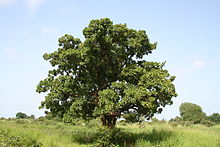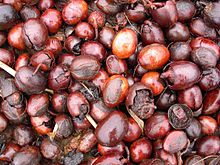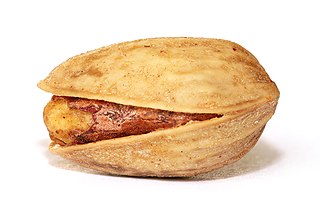
The pistachio, a member of the cashew family, is a small tree originating in Persia. The tree produces seeds that are widely consumed as food. The word can be countable or uncountable, meaning its plural is with or without an 's'.

The ackee, also known as acki, akee, or ackee apple, is a fruit of the Sapindaceae (soapberry) family, as are the lychee and the longan. It is native to tropical West Africa. The scientific name honours Captain William Bligh who took the fruit from Jamaica to the Royal Botanic Gardens in Kew, England, in 1793. The English common name is derived from the West African Akan akye fufo.
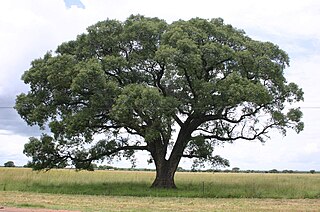
Sclerocarya birrea, commonly known as the marula, is a medium-sized deciduous fruit-bearing tree, indigenous to the miombo woodlands of Southern Africa, the Sudano-Sahelian range of West Africa, the savanna woodlands of East Africa and Madagascar.

The Sapotaceae are a family of flowering plants belonging to the order Ericales. The family includes about 800 species of evergreen trees and shrubs in around 65 genera. Their distribution is pantropical.

Shea butter is a fat extracted from the nut of the African shea tree. It is ivory in color when raw and commonly dyed yellow with borututu root or palm oil. It is widely used in cosmetics as a moisturizer, salve or lotion. It is edible and is used in food preparation in some African countries. It is occasionally mixed with other oils as a substitute for cocoa butter, although the taste is noticeably different.
Palm kernel oil is an edible plant oil derived from the kernel of the oil palm tree Elaeis guineensis. It is related to two other edible oils: palm oil, extracted from the fruit pulp of the oil palm, and coconut oil, extracted from the kernel of the coconut.

Irvingia gabonensis is a species of African trees in the genus Irvingia, sometimes known by the common names wild mango, African mango, or bush mango. They bear edible mango-like fruits, and are especially valued for their fat- and protein-rich nuts.
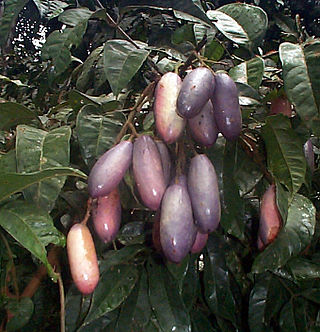
Dacryodes edulis is a fruit tree in the Burseraceae family native to Africa. Its various regional names include safou, messa, plum (Cameroon), atanga, ube, elumi (Nigeria), African pear, bush pear, African plum, nsafu, bush butter tree, or butterfruit.

Burkina Faso is largely wild bush country with a mixture of grass and small trees in varying proportions. The savanna region is mainly grassland in the rainy season and semi desert during the harmattan period. Fauna, one of the most diverse in West Africa, includes the elephant, hippopotamus, buffalo, monkey, lions, crocodile, giraffe, various types of antelope, and a vast variety of bird and insect life. The country has 147 mammal species, 330 aquatic species including 121 species of fish and 2067 different plant species. Of the plant species, the dominant endemic species are shea tree and the baobab, the former plant species has immense economic value to the country.

The Gambian epauletted fruit bat is a species of megabat in the family Pteropodidae. It is found in Benin, Burkina Faso, Cameroon, Central African Republic, Chad, Democratic Republic of the Congo, Ivory Coast, Ethiopia, Gambia, Ghana, Guinea, Guinea-Bissau, Liberia, Mali, Niger, Nigeria, Senegal, Sierra Leone, South Sudan, Sudan, and Togo. Its natural habitats are subtropical or tropical dry forests and savanna.

Boscia senegalensis, commonly known as hanza, is a member of the family Capparaceae.

Detarium senegalense is a leguminous tree in the subfamily Detarioideae. Unlike most members of the family, it produces globular fruits. Its common names include ditax, ditakh, detar, and tallow tree. The tree is of value for several reasons: the fruit is nutritious, is locally prominent in folk medicine, and is a source of quality timber. It could contribute to food security, sustainable land care, and rural development. As its Linnaean name indicates, it is native to Senegal and the surrounding countries of West Africa.
Zangasso is a small town and commune in the Cercle of Koutiala in the Sikasso Region of southern Mali. The commune covers an area of 452 square kilometers and includes 10 settlements. In the 2009 census it had a population of 19,925. The small town of Zangasso, the administrative centre (chef-lieu) of the commune, is 30 km southwest of Koutiala on the Route Nationale 11 that links Koutiala with Sikasso.
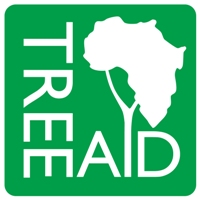
Tree Aid is an international development non-governmental organisation which focuses on working with people in the Sahel region in Africa to tackle poverty and the effects of climate change by growing trees, improving people's incomes, and restoring and protecting land. It is a registered charity in the UK. Tree Aid has offices in Ouagadougou, Burkina Faso, in Mali, in Ethiopia, in Ghana, and in Bristol, United Kingdom. It currently has programmes running in Burkina Faso, Ethiopia, Ghana, Mali and Niger. Areas of Tree Aid's work include forest governance, natural resource management, food security and nutrition, and enterprise development. Tree Aid reported in their annual impact report 2019/20, that since 1987 it had grown 22 million trees, worked with 1.8 million people, and supported 36,350 people in enterprise groups.

Treculia africana is a tree species in the genus Treculia which can be used as a food plant and for various other traditional uses. The fruits are hard and fibrous, can be the size of a volleyball and weight up to 8.5 kg (19 lb). Chimpanzees have been observed to use tools to break the fruits into small pieces that they can eat. The fruits contain polyphenols.

Vitellaria paradoxa is extremely important in Burkina Faso. Termed "women's gold" by Burkinabé villagers, the nuts of shea tree can be collected and processed by crushing and grinding to yield shea butter, which is widely used in soap and in cosmetics as a moisturizer, salve, or lotion. Shea butter is also edible and may be used in food preparation; it is sometimes used in the manufacture of chocolate. The bark of the tree is also used as an ingredient in traditional medicines and the shell of nut is said to be able to repel mosquitoes and is also said to protect existing trees.

Detarium microcarpum, commonly known as sweet detar, sweet dattock or tallow tree, is an underutilized species of tree legume that grows naturally in the drier regions of West and Central Africa. It has a wide range of uses due to its medicinal properties, edible fruit and hardwood, which is used as fuel. This makes it valuable and appreciated by local communities, but further research and effort are needed for its domestication.
Allanblackia oil is a vegetable oil that comes from the seeds of trees of the genus Allanblackia. This tree can be found in the wet tropical belt of Africa. Because of its unique blend of fatty acids, the oil from Allanblackia seeds has melting properties that make it excellent to use as structuring fat in food products, e.g. margarines.

Pentaclethra macrophylla, also known as the African oil bean, tree is a large size tree with long bipinnate compound leaves that is endemic to West and Central Africa. It is within the family Fabaceae. Seeds of the species are prepared and fermented to make Ugba, a soup condiment in Nigeria.
